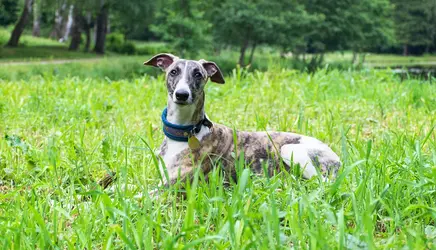Whippet: Breed Guide
- 25 Apr 2025
- 7m read

In this guide, we'll explore everything you need to know about the Whippet, from its history and unique traits to its exercise needs and health concerns. Whether you're a prospective Whippet owner or a lifelong fan of this remarkable breed, you'll find all the details here to help you make an informed decision and provide your dog with the best possible care.
Whippet Origin
The Whippet is a breed with deep roots in Great Britain. Known as small, short-haired greyhounds, these dogs were around as far back as the 16th century. While they were originally used for hunting, their primary role was to track and kill small vermin, making them valuable to farmers and working-class people. The term "Whippet" was first used around 1610, though the breed's distinctive characteristics didn’t fully develop until the 19th century.
The beginning
With the growing popularity of greyhound racing in the upper classes during the 19th century, the sport soon caught the interest of the working population of Great Britain. However, keeping larger dogs like greyhounds was expensive, and so breeders sought to create a smaller, more affordable alternative. By crossbreeding smaller greyhounds with Italian Greyhounds, they created a breed that was just as fast and agile but much less demanding in terms of upkeep.
There’s also evidence to suggest that long-legged terriers were included in the breeding programme, imparting the Whippet with a sharp instinct for game and smaller rodents. Early litters of greyhound crosses sometimes resulted in both smooth-coated and rough-coated puppies. The latter were less popular and eventually eliminated from the breed.
Development of the breed
In the 19th century, Whippet racing became a favourite pastime among communities of England, as well as their practical purposes, such as exterminating vermin. These dogs quickly became popular family companions thanks to their gentle nature, while their natural ability to chase and catch small animals ensured they were useful to many working households.
The breed was officially recognised by the British Kennel Club in 1891, solidifying its place in both competitive and domestic life in the UK.
Currently
Nowadays, the Whippet is primarily a family dog, although in some countries, racing these dogs is still very popular. Whippets do well in both houses with a garden and in smaller apartments.
What Were Whippets Bred For?
Whippets were originally bred for two main purposes: as agile and fast hunters of small game and vermin, and as companions to those who couldn’t afford larger greyhounds but still enjoyed racing. Their lightning-fast speed and keen hunting instincts made them invaluable on the hunt for rabbits, rats, and other small animals. Today, however, Whippets are more commonly family pets and companions, with some still participating in racing and other dog sports.
Whippet Breed Group
The Whippet belongs to the Hound Group. This is the same category as Grreyhounds, Salukis, and other breeds known for their speed and agility. These dogs were originally bred for their chasing ability, whether for racing or hunting.
Whippet Ideal Owner
The ideal Whippet owner is someone who can provide plenty of exercise, enjoys a quiet home, and is willing to spend time with a dog that thrives on companionship. Whippets are great for active families, singles, or even older adults, as long as their exercise needs are met. They are also well-suited to homes where they can be part of the family dynamic and enjoy regular outdoor activities.
Whippet Size
Whippets strike a perfect balance between agility and compactness. While they may not be as large as some of the more traditional sighthounds, their sleek, muscular build allows them to achieve impressive speeds.
How Big Do Whippets Get?
On average, Whippets stand about 18 to 22 inches (45 to 56 cm) tall at the shoulder.
How Much Should a Whippet Weigh?
A healthy Whippet typically weighs between 25 and 45 pounds (11 to 20 kg), with males generally being a bit larger than females. Weight should be monitored carefully, as these dogs can be prone to underweight or overfeeding due to their lean physique.
When Do Whippets Stop Growing?
Whippets generally stop growing at around 12-18 months of age, though their muscle mass may continue to develop into their second year. Growth can vary depending on genetics and diet.
Whippet Coat
Whippets have a short, fine coat that lies flat against their body. Their coat comes in a wide range of colours and patterns, from solid blacks and whites to brindle and tan. Their smooth, glossy fur contributes to their aerodynamic build, making them one of the fastest dog breeds in the world.
Do Whippets Shed?
Whippets do shed, but not excessively. Their short coat means that shedding is minimal and can be easily managed with regular brushing.
Are Whippets Hypoallergenic?
Whippets are not considered hypoallergenic, as they shed some dander. However, due to their short coat and low shedding, they might be more tolerable for people with mild allergies compared to other breeds.
How to Groom a Whippet
Whippets should be groomed regularly with a rubber glove or a currycomb - this will remove excess dead hair and improve circulation. The short, delicate fur of the Whippet does not collect dirt, so this dog does not require frequent bathing. Dried mud and dust can be easily removed with a bristle brush or a damp cloth.
Whippet Personality
Whippets are known for their gentle and affectionate nature. They are friendly, loyal dogs who thrive on human interaction. Though they may appear reserved around strangers, they are generally good with children and other pets in the home.
Are Whippets Good Family Dogs?
Yes, Whippets make excellent family dogs. Their calm, affectionate nature makes them ideal companions for children, and they’re often described as “gentle giants” due to their sweet disposition.
Are Whippets Easy to Train?
Whippets are intelligent and eager to please, making them relatively easy to train. However, they can be easily distracted by sights and smells due to their strong prey drive. Keep training sessions varied and engaging, as they can become bored with repetitive tasks.
Do Whippets Bark a Lot?
Whippets are generally not known for being excessive barkers. They are more likely to be quiet, especially indoors. However, they may bark to alert you of a stranger or when playing.
Are Whippets Intelligent?
Whippets are considered intelligent dogs, though they are not always as focused on obedience as some other breeds. They are more independent thinkers and might prefer to follow their own instincts, particularly when it comes to hunting.
Can Whippets Be Left Alone?
Whippets can tolerate being left alone for short periods, though they do better with human interaction. Being a social breed, they prefer to have company and can get anxious if left isolated for too long. Whippets should not be left alone for more than 4-5 hours at a time.
Can Whippets Swim?
Whippets are not natural swimmers, as their lean physique is built more for running than for water activities. However, some individual Whippets enjoy swimming, especially if introduced to it gently at a young age.
Whippet Exercise
Whippets require a lot of exercise. They especially love to run freely, although will also enjoy long, leisurely walks combined with exploring the surroundings.
How Much Exercise Does a Whippet Need?
Whippets need at least 30 minutes to 1 hour of exercise each day, though they are capable of handling more if given the opportunity to run in a safe, enclosed space. They love to stretch their legs, so off-lead time in a secure environment is ideal.
Whippet Health
Like all breeds, Whippets are prone to certain health conditions, but with the right care, they can live long, happy lives. Their athletic nature and lean build make them generally healthy dogs, but it’s important to stay informed about the specific health issues they may face.
Are Whippets Prone to Any Health Conditions?
However, they can be prone to several diseases typical of this breed. Among the health problems that occur in whippets are:
hip dysplasia,
patella dislocation,
congenital deafness,
cryptorchidism,
cataract,
lens dislocation,
hypothyroidism,
mitral valve insufficiency,
kidney disease,
skin cancers,
pancreatitis ,
food and contact allergies.
Due to their high physical activity, English Greyhounds often suffer from various injuries, and their delicate skin is susceptible to various types of wounds. Greyhounds with the MDR1 gene mutation are hypersensitive to agents used during anesthesia, some medications, and antiparasitic agents.
Whippet Cost
Before bringing a Whippet into your home, it's important to consider the financial commitment involved. The cost of buying a Whippet can vary depending on factors such as whether you're purchasing from a breeder or adopting from a rescue centre. In addition to the initial cost, there are ongoing expenses related to their care, including food, grooming, veterinary bills, and other essentials.
How Much Do Whippets Cost?
Whippets generally cost between £500 and £1,200 in the UK, depending on factors such as pedigree, breeder reputation, and geographical location. Rescue Whippets are also available, and adopting a dog can often be a more affordable option.




